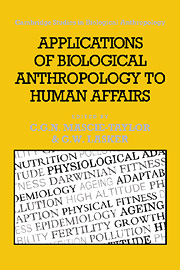Book contents
- Frontmatter
- Contents
- List of contributors
- 1 Introduction
- 2 Reproductive ecology and human fertility
- 3 Nutritional status: its measurement and relation to health
- 4 Pollution and human growth: lead, noise, polychlorobiphenyl compounds and toxic wastes
- 5 Human physiological adaptation to high-altitude environments
- 6 Darwinian fitness, physical fitness and physical activity
- 7 Human evolution and the genetic epidemiology of chronic degenerative diseases
- 8 The biology of human aging
- Index
4 - Pollution and human growth: lead, noise, polychlorobiphenyl compounds and toxic wastes
Published online by Cambridge University Press: 03 May 2010
- Frontmatter
- Contents
- List of contributors
- 1 Introduction
- 2 Reproductive ecology and human fertility
- 3 Nutritional status: its measurement and relation to health
- 4 Pollution and human growth: lead, noise, polychlorobiphenyl compounds and toxic wastes
- 5 Human physiological adaptation to high-altitude environments
- 6 Darwinian fitness, physical fitness and physical activity
- 7 Human evolution and the genetic epidemiology of chronic degenerative diseases
- 8 The biology of human aging
- Index
Summary
Growth is one of the best indices of child health we have, and a continuous monitoring of the growth and development of children in under-and over-nourished populations is, or should be, a major concern of all public health authorities and governments.
(Tanner, 1966: p.46)Environmental contamination from industrialization and modern agriculture is believed to be widespread. In many heavily industrialized countries, the public is partially informed and quite fearful of the biological effects of this contamination (Anderson, 1985). Scientific knowledge of the effects of new substances on health and adaptation has not kept pace with the speed of environmental change. Scientific interest is warranted not only because of public concern, but also because there are questions of biological adaptation to resolve. Environmental contamination is regrettable; however, it presents an opportunity to examine human biological adaptation to a rapidly changing environment. This may help to clarify the relationship between adaptation and community health.
The subject of study, environmental contamination, is an ill-defined phenomenon. Although it can be defined as the effect of pollution, pollution is an equally ambiguous concept. It is recognizable, but has no specific empirical referent. Its definition is, therefore, somewhat arbitrary. Pollution may be defined by source – that is, the product of human vs. non-human activity – but many naturally occurring environmental components (such as volcanic ash or methane) would be excluded by this definition despite their similarity to human products in terms of chemical composition and health effects.
- Type
- Chapter
- Information
- Applications of Biological Anthropology to Human Affairs , pp. 83 - 116Publisher: Cambridge University PressPrint publication year: 1991
- 2
- Cited by



